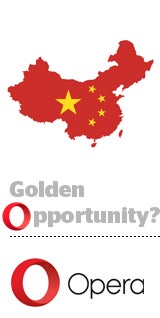 China is a market that gets people excited – a largely untapped potential audience of more than 1 billion people.
China is a market that gets people excited – a largely untapped potential audience of more than 1 billion people.
It’s certainly one of the stated “strategic rationales” behind the recent $1.2 billion buyout offer that browser maker Opera received from a consortium of Chinese companies, including mobile game maker Kunlun and security software provider Qihoo.
Although Opera’s board has already given the acquisition its blessing, shareholders will still need to approve it.
Opera positioned the deal as a sort of quid pro quo. It would get direct access to the Chinese user bases of both Kunlun and Qihoo, and, in turn, Kunlun and Qihoo could take advantage of Opera’s own Internet user base of roughly 350 million, as well as its mobile ad platform, Opera Mediaworks.
Sounds simple enough on paper – but putting it into practice is going to be anything but, said Aurelie Guerrieri, VP of global marketing solutions at Chinese mobile media company Cheetah Mobile.
“The vision is great,” said Guerrieri. “The execution, though, is going to be a challenge.”
For one, Opera Mediaworks is a tech stack in the truest sense of the word “stack” – as in a pile of objects. Mediaworks comprises a medley of acquisitions, including mobile video ad network AdColony; mobile ad server AdMarvel; four different mobile ad networks (AdVine, Mobile Theory, Apprupt and 4th Screen); mobile video optimization company Skyfire Labs; mobile monetization provider Hunt Mobile Ads; and app store platform Handster.
“A consortium is, by definition, made up of multiple parties with varying interests and strategic goals, and Opera is an entity comprising many entities,” Guerrieri said. “It makes one wonder how much integration has already happened within Opera and if it’s one platform now or many.”
Because taking advantage of this sort of opportunity – global brands reaching users in China and Chinese companies breaking out of their own borders – is about more than plugging everyone’s respective inventory into the Opera Mediaworks stack and calling it a day.
US brands in particular expect a certain level of transparency around their media buying (whether they get it or not). The existing infrastructure within China could make that difficult to achieve, said Rajeev Goel, CEO and co-founder of sell-side platform PubMatic, which recently partnered with Tencent to monetize the latter’s non-Chinese inventory.
Although Opera’s clients could conceivably plug into “big pools of Chinese inventory and execute their buys in a technology stack they’re already comfortable with,” namely, Opera Mediaworks, “undoubtedly, there are going to be complexities around it,” Goel said.
For example, third-party data management platforms aren’t widely used in China, and most of the targeting data within China comes courtesy of homegrown walled gardens – Baidu, Alibaba and Tencent. And that can be a hindrance to programmatic buying.
“The data ecosystem in China is not as mature as it is in Europe or the US, so targeting can be a challenge, and it’s difficult to build a rich profile based on cookies or a consumer’s device, which makes it hard to know the real composition of the audience you’re targeting,” Goel said. “Opera will need to make some modifications – maybe it’s something they’re already working on – to ensure their stack operates in China according to the practices and standards that exist there.”
There also might be something lost in the translation for Chinese brands looking to tackle international markets. Although Chinese advertisers and publishers are starting to embrace programmatic, most are still accustomed to buying and selling on a cost-per-day (CPD) rather than a CPM basis. Non-Chinese advertisers with their eye on China will also have to get used to CPD pricing.
But beyond the practical question of “how,” is the question of whether it even makes sense for a non-Chinese brand to try to crack the Chinese market, said Rachel Pasqua, practice lead for mobile and emerging technologies at MEC Global, North America. MEC has run campaigns through Opera Mediaworks “from time to time,” mainly taking advantage of mobile video ad network AdColony.
A truly global brand like Coke is one thing. Every human on Earth is a potential target. But what about a US-based canned soup company or a French mustard maker?
“It’s just very uncharted territory,” Pasqua said. “If you’re a US brand selling fast food or crackers or whatever it is, the idea that you could reach another billion plus people is compelling. But if you’re trying to convince Chinese mothers to buy your snacks, how do you edge out the most popular lunchbox snack maker in China? Reach and opportunity is one thing – but qualifying the opportunity is quite another.”
For her part, Pasqua, who said she has ad blocking on the brain, is more impressed by Opera’s data compression technology, Opera Max, than by its mobile ad offering. Launched in February 2014, Opera Max is a Android app that helps other apps on a device run faster, while conserving data and cutting down on buffering.
The combination of Opera Max and Opera Mediaworks could prove to be interesting, Pasqua said, especially considering Opera’s mobile footprint. Opera has its own app store and a well-penetrated mobile browser, Opera Mini. As of July 2015, Opera Mini had a global user base of around 250 million.
“The ad network stuff is somewhat obvious – opening up new channels for Chinese companies in the US and for US advertisers in China,” she said. “But if you could make sure that the ads running on a certain site or within a certain game won’t compromise the performance or jack up the data cost for users, that could be a powerful long-term offering.”












